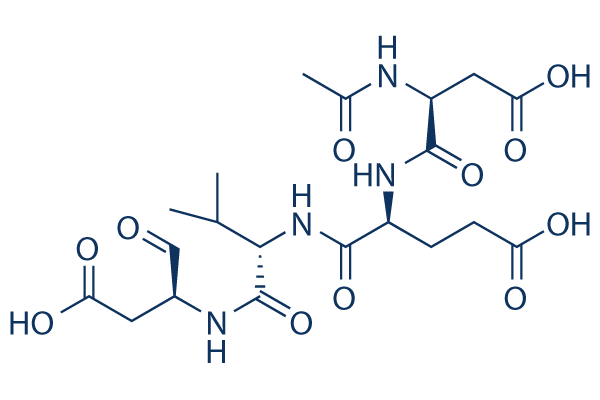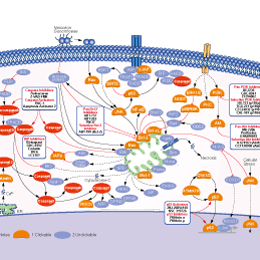
- Bioactive Compounds
- By Signaling Pathways
- PI3K/Akt/mTOR
- Epigenetics
- Methylation
- Immunology & Inflammation
- Protein Tyrosine Kinase
- Angiogenesis
- Apoptosis
- Autophagy
- ER stress & UPR
- JAK/STAT
- MAPK
- Cytoskeletal Signaling
- Cell Cycle
- TGF-beta/Smad
- Compound Libraries
- Popular Compound Libraries
- Customize Library
- Clinical and FDA-approved Related
- Bioactive Compound Libraries
- Inhibitor Related
- Natural Product Related
- Metabolism Related
- Cell Death Related
- By Signaling Pathway
- By Disease
- Anti-infection and Antiviral Related
- Neuronal and Immunology Related
- Fragment and Covalent Related
- FDA-approved Drug Library
- FDA-approved & Passed Phase I Drug Library
- Preclinical/Clinical Compound Library
- Bioactive Compound Library-I
- Bioactive Compound Library-Ⅱ
- Kinase Inhibitor Library
- Express-Pick Library
- Natural Product Library
- Human Endogenous Metabolite Compound Library
- Alkaloid Compound LibraryNew
- Angiogenesis Related compound Library
- Anti-Aging Compound Library
- Anti-alzheimer Disease Compound Library
- Antibiotics compound Library
- Anti-cancer Compound Library
- Anti-cancer Compound Library-Ⅱ
- Anti-cancer Metabolism Compound Library
- Anti-Cardiovascular Disease Compound Library
- Anti-diabetic Compound Library
- Anti-infection Compound Library
- Antioxidant Compound Library
- Anti-parasitic Compound Library
- Antiviral Compound Library
- Apoptosis Compound Library
- Autophagy Compound Library
- Calcium Channel Blocker LibraryNew
- Cambridge Cancer Compound Library
- Carbohydrate Metabolism Compound LibraryNew
- Cell Cycle compound library
- CNS-Penetrant Compound Library
- Covalent Inhibitor Library
- Cytokine Inhibitor LibraryNew
- Cytoskeletal Signaling Pathway Compound Library
- DNA Damage/DNA Repair compound Library
- Drug-like Compound Library
- Endoplasmic Reticulum Stress Compound Library
- Epigenetics Compound Library
- Exosome Secretion Related Compound LibraryNew
- FDA-approved Anticancer Drug LibraryNew
- Ferroptosis Compound Library
- Flavonoid Compound Library
- Fragment Library
- Glutamine Metabolism Compound Library
- Glycolysis Compound Library
- GPCR Compound Library
- Gut Microbial Metabolite Library
- HIF-1 Signaling Pathway Compound Library
- Highly Selective Inhibitor Library
- Histone modification compound library
- HTS Library for Drug Discovery
- Human Hormone Related Compound LibraryNew
- Human Transcription Factor Compound LibraryNew
- Immunology/Inflammation Compound Library
- Inhibitor Library
- Ion Channel Ligand Library
- JAK/STAT compound library
- Lipid Metabolism Compound LibraryNew
- Macrocyclic Compound Library
- MAPK Inhibitor Library
- Medicine Food Homology Compound Library
- Metabolism Compound Library
- Methylation Compound Library
- Mouse Metabolite Compound LibraryNew
- Natural Organic Compound Library
- Neuronal Signaling Compound Library
- NF-κB Signaling Compound Library
- Nucleoside Analogue Library
- Obesity Compound Library
- Oxidative Stress Compound LibraryNew
- Plant Extract Library
- Phenotypic Screening Library
- PI3K/Akt Inhibitor Library
- Protease Inhibitor Library
- Protein-protein Interaction Inhibitor Library
- Pyroptosis Compound Library
- Small Molecule Immuno-Oncology Compound Library
- Mitochondria-Targeted Compound LibraryNew
- Stem Cell Differentiation Compound LibraryNew
- Stem Cell Signaling Compound Library
- Natural Phenol Compound LibraryNew
- Natural Terpenoid Compound LibraryNew
- TGF-beta/Smad compound library
- Traditional Chinese Medicine Library
- Tyrosine Kinase Inhibitor Library
- Ubiquitination Compound Library
-
Cherry Picking
You can personalize your library with chemicals from within Selleck's inventory. Build the right library for your research endeavors by choosing from compounds in all of our available libraries.
Please contact us at [email protected] to customize your library.
You could select:
- Antibodies
- Bioreagents
- qPCR
- 2x SYBR Green qPCR Master Mix
- 2x SYBR Green qPCR Master Mix(Low ROX)
- 2x SYBR Green qPCR Master Mix(High ROX)
- Protein Assay
- Protein A/G Magnetic Beads for IP
- Anti-Flag magnetic beads
- Anti-Flag Affinity Gel
- Anti-Myc magnetic beads
- Anti-HA magnetic beads
- Poly FLAG Peptide lyophilized powder
- Protease Inhibitor Cocktail
- Protease Inhibitor Cocktail (EDTA-Free, 100X in DMSO)
- Phosphatase Inhibitor Cocktail (2 Tubes, 100X)
- Cell Biology
- Cell Counting Kit-8 (CCK-8)
- Animal Experiment
- Mouse Direct PCR Kit (For Genotyping)
- New Products
- Contact Us
Ac-DEVD-CHO
Synonyms: Caspase-3 Inhibitor I, N-Ac-Asp-Glu-Val-Asp-CHO
Ac-DEVD-CHO (Caspase-3 Inhibitor I, N-Ac-Asp-Glu-Val-Asp-CHO) is a potent aldehyde inhibitor of Group II caspases with Ki values of 0.2 nM and 0.3 nM for for caspase-3 and caspase-7, respectively. Weak inhibition for caspase-2.

Ac-DEVD-CHO Chemical Structure
CAS: 169332-60-9
Selleck's Ac-DEVD-CHO has been cited by 29 Publications
1 Customer Review
Purity & Quality Control
Batch:
S790101
Water]
100 mg/mL]
false]
]
]
false]
]
]
false
Purity:
98.86%
98.86
Ac-DEVD-CHO Related Products
| Related Targets | Caspase-1 Caspase-3 Caspase-8 Caspase-9 Caspase-4 Capase-7 Caspase-2 Caspase-5 Caspase-6 Caspase-10 Caspase-7 | Click to Expand |
|---|---|---|
| Related Products | Z-VAD-FMK Belnacasan (VX-765) Z-DEVD-FMK Q-VD-Oph Z-IETD-FMK Emricasan (IDN-6556) Z-LEHD-FMK TFA Z-VAD(OH)-FMK (Caspase Inhibitor VI) PAC-1 Z-YVAD-FMK Apoptosis Activator 2 Taurochenodeoxycholic acid Tasisulam Phenoxodiol (Haginin E) | Click to Expand |
| Related Compound Libraries | Autophagy Compound Library Apoptosis Compound Library Ferroptosis Compound Library Pyroptosis Compound Library Mitochondria-Targeted Compound Library | Click to Expand |
Signaling Pathway
Choose Selective Caspase Inhibitors
Biological Activity
| Description | Ac-DEVD-CHO (Caspase-3 Inhibitor I, N-Ac-Asp-Glu-Val-Asp-CHO) is a potent aldehyde inhibitor of Group II caspases with Ki values of 0.2 nM and 0.3 nM for for caspase-3 and caspase-7, respectively. Weak inhibition for caspase-2. | |||||||||||
|---|---|---|---|---|---|---|---|---|---|---|---|---|
| Targets |
|
| In vitro | ||||
| In vitro | Ac-DEVD-CHO is a potent inhibitor of caspase-3 (Ki = 230 pM). In contrast, caspase-2 cleaves the tetrapeptide substrate poorly and is only weakly inhibited by this aldehyde (Ki = 1.7 μM). Group III caspases are broadly inhibited by Ac-DEVD-CHO with Ki values ranging from 1 to 300 nM[1]. Inhibition of caspase-3 by Ac-DEVD-CHO in isolated working-heart rat model significantly improves post-ischemic contractile recovery of stunned myocardium, even when given after the onset of ischemia. The mechanism(s) of protection by Ac-DEVD-CHO appear to be independent of apoptosis. Troponin I cleavage was not inhibited by Ac-DEVD-CHO[2]. | |||
|---|---|---|---|---|
| Cell Research | Cell lines | MEFs | ||
| Concentrations | 20, 50 μM | |||
| Incubation Time | 2 h | |||
| Method | Apaf-1−/− cells were treated with the indicated concentration of Ac-DEVD-CHO for 2 h prior to treatment with 4 μM CHX alone or with TNF for 6 h. LEHDase and DEVDase activities were standardized to the lactate dehydrogenase activity in the sample and are presented as percentages of the activity in TNF-plus-CHX-treated cells not treated with Ac-DEVD-CHO (0 μM). |
|||
| In Vivo | ||
| In vivo | Ac-DEVD-CHO administered at the time of MI results in a 61% reduction in activated caspase-3 expression in cardiomyocytes (p<0.05), and an 84% reduction in cardiomyocyte apoptosis in the young animals. However, in the aging mice, caspase inhibition had no effect on activated caspase-3 expression or cardiomyocyte apoptosis[4]. Ac-DEVD-CHO suppressed and/or delayed the progression of photoreceptor cell damage in rats and delays disease progression in rd gene-carring mice, which normally develop retinal degeneration early in life[2]. | |
|---|---|---|
| Animal Research | Animal Models | C57Bl6 mice |
| Dosages | 3 mg/kg | |
| Administration | i.p. | |
Chemical Information & Solubility
| Molecular Weight | 502.47 | Formula | C20H30N4O11 |
| CAS No. | 169332-60-9 | SDF | Download Ac-DEVD-CHO SDF |
| Smiles | CC(C)C(C(=O)NC(CC(=O)O)C=O)NC(=O)C(CCC(=O)O)NC(=O)C(CC(=O)O)NC(=O)C | ||
| Storage (From the date of receipt) | |||
|
In vitro |
Water : 100 mg/mL |
Molecular Weight Calculator |
|
In vivo Add solvents to the product individually and in order. |
In vivo Formulation Calculator |
||||
Preparing Stock Solutions
Molarity Calculator
In vivo Formulation Calculator (Clear solution)
Step 1: Enter information below (Recommended: An additional animal making an allowance for loss during the experiment)
mg/kg
g
μL
Step 2: Enter the in vivo formulation (This is only the calculator, not formulation. Please contact us first if there is no in vivo formulation at the solubility Section.)
% DMSO
%
% Tween 80
% ddH2O
%DMSO
%
Calculation results:
Working concentration: mg/ml;
Method for preparing DMSO master liquid: mg drug pre-dissolved in μL DMSO ( Master liquid concentration mg/mL, Please contact us first if the concentration exceeds the DMSO solubility of the batch of drug. )
Method for preparing in vivo formulation: Take μL DMSO master liquid, next addμL PEG300, mix and clarify, next addμL Tween 80, mix and clarify, next add μL ddH2O, mix and clarify.
Method for preparing in vivo formulation: Take μL DMSO master liquid, next add μL Corn oil, mix and clarify.
Note: 1. Please make sure the liquid is clear before adding the next solvent.
2. Be sure to add the solvent(s) in order. You must ensure that the solution obtained, in the previous addition, is a clear solution before proceeding to add the next solvent. Physical methods such
as vortex, ultrasound or hot water bath can be used to aid dissolving.
Tech Support
Answers to questions you may have can be found in the inhibitor handling instructions. Topics include how to prepare stock solutions, how to store inhibitors, and issues that need special attention for cell-based assays and animal experiments.
Tel: +1-832-582-8158 Ext:3
If you have any other enquiries, please leave a message.
* Indicates a Required Field
Tags: buy Ac-DEVD-CHO | Ac-DEVD-CHO supplier | purchase Ac-DEVD-CHO | Ac-DEVD-CHO cost | Ac-DEVD-CHO manufacturer | order Ac-DEVD-CHO | Ac-DEVD-CHO distributor








































